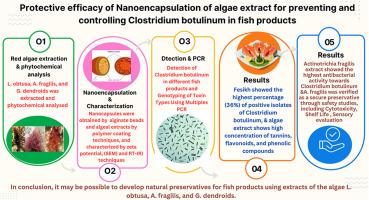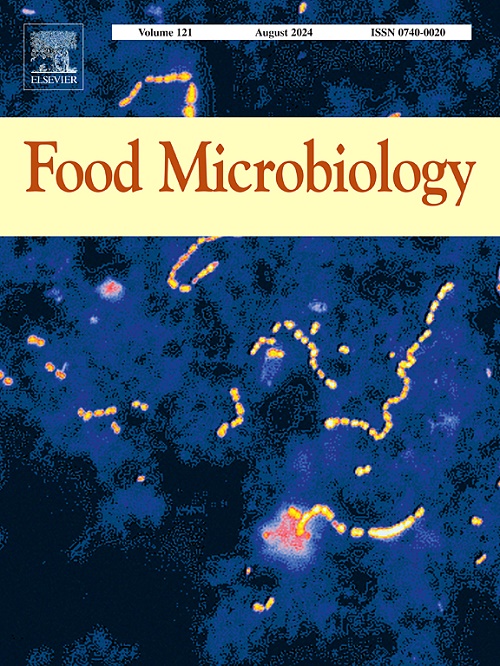Protective efficacy of nanoencapsulation of algal extract for preventing and controlling Clostridium botulinum in fish products
IF 4.6
1区 农林科学
Q1 BIOTECHNOLOGY & APPLIED MICROBIOLOGY
引用次数: 0
Abstract
Research is being conducted on the usage of algae extracts as natural preservatives in the storage of fish products to extend shelf life, maintain quality and safety, and satisfy consumer preferences. Laurencia obtusa (Hudson), Actinotrichia fragilis (Forsskål) Børgesen, and Gracilaria dendroids sp. nov. are three species of red algae assumed to possess antibacterial properties. The objective of our study was to ascertain whether the nanocapsules of these algal extracts may be employed as a food preservation agent to inhibit the pathogenic bacteria Clostridium botulinum, which is prevalent in several fish products (fish burgers, fish fillets, Fesikh, Renga, canned tuna, canned mackerel, and canned sardines). Nanocapsules were synthesized using polymer coating techniques and characterized by zeta potential, scanning electron microscopy (SEM), and Fourier transform infrared spectroscopy (FT-IR) techniques. The results revealed that Fesikh showed the highest percentage (36 %) of positive isolates of C. botulinum. The antibacterial activity assessment revealed that the nanoencapsulation of A. fragilis extract exhibited the most significant antibacterial activity towards C. botulinum. This was attributed to the high concentrations of tannins, flavonoids, and phenolic compounds, which demonstrated antimicrobial properties. The findings indicated that the application of A. fragilis nanoencapsulated algae extract in the preservation of fish products decreased the total bacterial count. Meanwhile, A. fragilis was verified as a secure preservative through safety assessments, encompassing cytotoxicity, shelf life, and sensory evaluation.
In summary, the algal extracts from L. obtusa, A. fragilis, and G. dendroids exhibited high levels of phenolic compounds, potent antioxidant effects, and significant antibacterial activity; hence, they can be developed as natural preservatives for fish products.

藻提取物纳米包封对鱼制品肉毒杆菌的防治作用
目前正研究使用藻类提取物作为天然防腐剂储存鱼类产品,以延长保质期,保持质量和安全,并满足消费者的喜好。Laurencia obtusa (Hudson)、Actinotrichia fragilis (forssk) Børgesen和Gracilaria denendroids sp. 11 .是三种被认为具有抗菌特性的红藻。我们研究的目的是确定这些藻类提取物的纳米胶囊是否可以作为食品保鲜剂来抑制致病菌肉毒杆菌,肉毒杆菌普遍存在于几种鱼类产品中(鱼汉堡、鱼片、Fesikh、Renga、金枪鱼罐头、鲭鱼罐头和沙丁鱼罐头)。采用聚合物包覆技术合成了纳米胶囊,并通过zeta电位、扫描电镜(SEM)和傅里叶变换红外光谱(FT-IR)技术对其进行了表征。结果显示,Fesikh地区肉毒杆菌阳性分离株比例最高(36%)。抑菌活性评价结果表明,脆弱草提取物的纳米包封对肉毒杆菌的抑菌活性最显著。这是由于高浓度的单宁、黄酮类化合物和酚类化合物,它们具有抗菌特性。结果表明,微囊藻提取物在鱼制品保存过程中可降低鱼制品细菌总数。同时,通过包括细胞毒性、保质期和感官评价在内的安全性评估,验证了脆弱芽孢杆菌是一种安全的防腐剂。综上所述,钝藻、脆弱藻和树突藻提取物具有高水平的酚类化合物、强抗氧化作用和显著的抗菌活性;因此,它们可以被开发为鱼类产品的天然防腐剂。
本文章由计算机程序翻译,如有差异,请以英文原文为准。
求助全文
约1分钟内获得全文
求助全文
来源期刊

Food microbiology
工程技术-生物工程与应用微生物
CiteScore
11.30
自引率
3.80%
发文量
179
审稿时长
44 days
期刊介绍:
Food Microbiology publishes original research articles, short communications, review papers, letters, news items and book reviews dealing with all aspects of the microbiology of foods. The editors aim to publish manuscripts of the highest quality which are both relevant and applicable to the broad field covered by the journal. Studies must be novel, have a clear connection to food microbiology, and be of general interest to the international community of food microbiologists. The editors make every effort to ensure rapid and fair reviews, resulting in timely publication of accepted manuscripts.
 求助内容:
求助内容: 应助结果提醒方式:
应助结果提醒方式:


